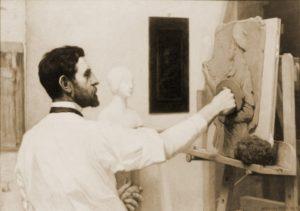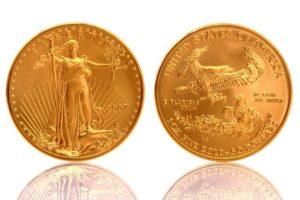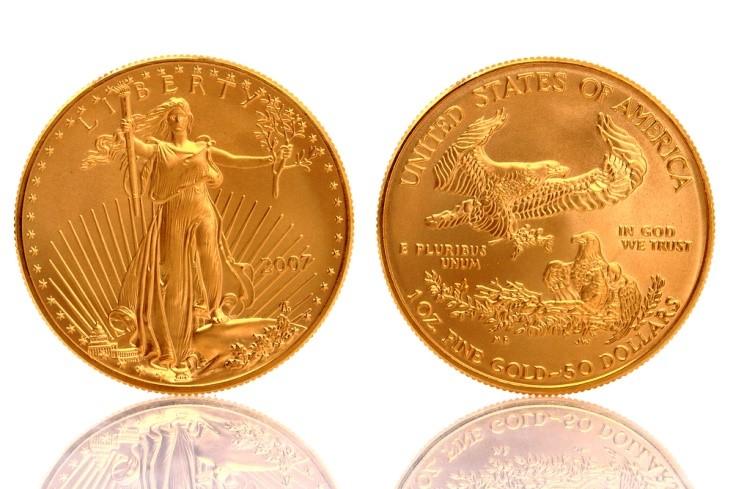As collectors know, coins are not only coveted for their intrinsic value and rarity, but because they are works of art as well. One of the most beautiful coins still being minted today is the American Gold Eagle. Created from gold mined solely in America, its two sides feature reliefs designed by highly skilled artists whose names are famous in the world of art and coin design.
Obverse Side
The front, or obverse, side of the coin displays a rendering of a full-length figure of Lady Liberty, her flowing hair caught by a breeze, with her right hand holding aloft a torch while her outstretched left hand holds an olive branch. The image is adapted from a relief by Augustus Saint-Gaudens for what is known as the Double Eagle coin commissioned by President Theodore Roosevelt in the early 1900s.
 Artist Augustus Saint-Gaudens
Artist Augustus Saint-Gaudens
Saint-Gaudens himself was born in Dublin in 1848, but raised from infancy in New York. After a teenage apprenticeship as a cameo cutter, he spent the next years studying sculpture, art, and architecture.
Sculpture Work
His first major commission, while still in his twenties, was for a bronze memorial to U.S. Navy Admiral David Farragut, the great Civil War leader maybe best known today for commanding “Damn the torpedoes, full speed ahead!”
The statue of Farragut was unveiled in 1881 in New York’s Madison Square Park on a pedestal designed by famed architect Stanford White, and it still stands today, considered one of the finest monuments in the city.
Saint-Gaudens’ larger than life Abraham Lincoln: The Man (also known as the Standing Lincoln) in Chicago’s Lincoln Park was an especially significant commission for him. At the age of thirteen, the sculptor had watched Abraham Lincoln riding on the train to his inauguration in Washington, D., and four years later he had joined the immense crowd paying its respects as Lincoln lay in state following his assassination.
In creating the statue, Saint-Gaudens used the life mask and the casts of Lincoln’s hands that had been made by sculptor Leonard Volk in 1860, shortly before Lincoln received the nomination for the presidency. The statue was unveiled in 1887, and many public commissions followed, including Saint-Gaudens’ Abraham Lincoln: The Head of State, which shows a seated Lincoln in the throes of the war, created for the Lincoln Centennial.
Coinage Work
At the start of the new, 20th century, President Theodore Roosevelt chose Saint-Gaudens to redesign the nation’s coinage. The sculptor created an ultra high-relief $20 gold piece in 1907, of which only about twenty were minted because it took up to eleven strikes to bring up the details and the coins didn’t stack well, making them unfit for commerce. One of these coins sold at auction in 2005 for just under $3 million.
The U.S. Mint then adapted the coin into a high-relief version, which took three strikes to complete and were also deemed unsuitable, although 12,317 of the now sought-after coins were minted. Finally, the coin was modified to a standard relief version, and was produced from 1907 to 1933. Its beautiful Lady Liberty was brought back to life in 1986 for the American Eagle gold bullion coin.
Reverse Side
The American Eagle’s reverse side came into being in an entirely different way. Self-taught artist Miley Busiek (now known as Miley Tucker-Frost) had been commissioned in 1980 to create a small sculpture as a souvenir for Ronald Reagan’s first inaugural, based on her rendering of a family of eagles. Soon after, the artist saw a Wall Street Journal article reporting that there was a move afoot to gain approval from Congress for a new U.S. gold bullion coin.
Artist Miley Busiek
Busiek wanted to offer her “Family of Eagles” design for the coin, and mounted a years-long effort to campaign for it. She began by approaching civic, political, religious, and business leaders in her Dallas hometown, enlisted Dallas Cowboys coach Tom Landry, and made trips to Washington, D.C., to lobby Congress and testify at hearings on coinage legislation.
Finally, in 1985, after President Reagan imposed a ban on importation of the Kruggerand, South Africa’s one-ounce gold bullion coin, Congress decided it was time for an American bullion coin. The legislation creating it stipulated that the coin carry the image of a male eagle “carrying an olive branch and flying above a nest containing a female eagle and hatchlings.” The bill didn’t mention Busiek by name, but there was no doubt it referred to her design.
Craftspeople at the U.S. Mint created the relief and engraving from Busiek’s drawing, and she and her sons were given the opportunity to strike examples of the coin when it was first minted in 1986. “The spirit behind this design was to honor our family and America,” she says, and views the donation of her work as “a gift to my fellow Americans.”

